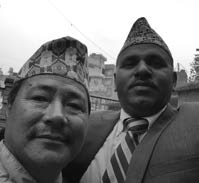Man Bahadur Rai and his family believed that six spirits inhabited their home in a rural village near Nepal’s border with China.
Six clay pots were placed around the home for the spirits to live in. Whenever Mother cooked a meal, she placed food into each pot for the spirits to eat. She feared that if even one spirit were forgotten, the whole family would suffer indigestion - or worse.
The parents wielded great influence in the village as the local spiritual leaders, and they hated Christianity, the belief in an unseen God. They preferred their visible gods of metal and wood.
One evening, 18-year-old Man was walking home after work and heard a male voice speaking about a virgin who had a child. Man wondered who was making such an illogical statement. He followed the voice a building and saw a man reading from a black book.
After the meeting, Man fiercely argued with the man over his teachings. The man, a visiting Seventh-day Adventist pastor, simply smiled and invited the teen to return the next evening.
After a week of meetings, Man obtained a Bible and determined to prove it wrong. The more he read, however, the more he felt convinced that Jesus is the living God. He gave his heart to Jesus.
Father was furious when Man announced that he had become a Christian. He badly beat the teen and chased him from the village.
Mother wept all night. In the morning, she asked a friend to find her son and give him a lamb.
Man accepted the lamb with joy and, after praying, felt a strong impression to sell it - and buy a volleyball ball and net. Finding a piece of unused land between five villages, Man set up the new volleyball net and started to play.
Soon several young people passed by and asked if they could join him. “Sure”, Man said. “But you have to memorize one Bible verse”.
The young people eagerly memorized a verse and began to play. As they played, other young people stopped and memorized verses to join in. When the matych ended, the young people pleaded to play again.
“OK”, Man said. “But first you have to learn a song about my God”.
Before long, many young people had memorized whole Bible chapters and many Christian songs.
Then Man heard that I would conduct a Bible school, and he shared his story on the first day. He introduced three young men seated nearby. “This is the result of my volleyball evangelism”, he said. “These men have accepted Jesus and want to become Bible workers, too”.
Man, left, who has been disowned by his family, is no theologian. He is a frontline worker building a new family who will live forever in God’s kingdom.
Wilson Measapogu is executive secretary of the Seventh-day Adventist Church’s Southern Asia Division.

